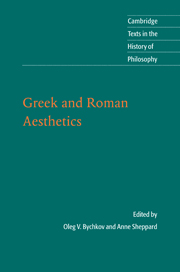Book contents
- Frontmatter
- Contents
- Preface
- Introduction
- Chronology
- Further reading
- Note on the texts and the translations
- Greek and Roman Aesthetics
- Gorgias
- Plato
- Xenophon
- Aristotle
- Philodemus
- Cicero
- Seneca
- Longinus
- Philostratus
- Philostratus the Younger
- Aristides Quintilianus
- Plotinus
- Augustine
- Proclus
- Index
- CAMBRIDGE TEXTS IN THE HISTORY OF PHILOSOPHY
Plotinus
Published online by Cambridge University Press: 05 June 2012
- Frontmatter
- Contents
- Preface
- Introduction
- Chronology
- Further reading
- Note on the texts and the translations
- Greek and Roman Aesthetics
- Gorgias
- Plato
- Xenophon
- Aristotle
- Philodemus
- Cicero
- Seneca
- Longinus
- Philostratus
- Philostratus the Younger
- Aristides Quintilianus
- Plotinus
- Augustine
- Proclus
- Index
- CAMBRIDGE TEXTS IN THE HISTORY OF PHILOSOPHY
Summary
Enneads
1.6
The beautiful is mostly found in sight but also in things that we hear, in arrangements of words and also in music, that is, in all kinds of music – for indeed, tunes and rhythms are beautiful. For those who are advancing upwards, away from the realm of perception, practices are also beautiful, as are actions, dispositions and types of knowledge; and there is also beauty of the virtues. If there is any further beauty prior to these, this discussion will make it plain.
So what is it that has made us imagine bodies to be beautiful and has made hearing approve of sounds as beautiful? How are all the things beautiful which depend, one after another, on the soul? Is everything made beautiful by one and the same beauty or is bodily beauty different from other kinds? What are these things, or this thing? Some things, such as bodies, are beautiful not because of what they are in themselves but by participation, while others, like the nature of virtue, are beautiful in themselves. The same bodies appear sometimes beautiful, sometimes not since being bodies and being beautiful are different things. So what is this which is present in bodies? We should consider this first. What is it that attracts the eyes of spectators, turns them towards itself, draws them on and makes them enjoy the sight? For if we discover this we can perhaps ‘use it as a ladder’ and have a view of the rest.
- Type
- Chapter
- Information
- Greek and Roman Aesthetics , pp. 185 - 200Publisher: Cambridge University PressPrint publication year: 2010

